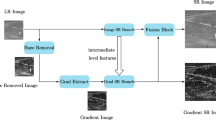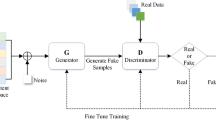Abstract
Due to the limitations of infrared imaging principles and imaging systems, many problems are typically encountered with collected infrared images, such as low resolution, insufficient detail information, and blurred edges. In response to these problems, a method of infrared image super-resolution reconstruction that uses recursive attention and is based on a generative adversarial network is proposed. First, according to the characteristics of low-resolution infrared images such as uniform pixel distributions, low contrast, and poor perceived quality, a deep generator structure with a recursive-attention network is designed in this article. The recursive-attention module is used to extract high-frequency information from the feature maps, suppress useless information, and enhance the expressiveness of the features, which facilitates the reconstruction of texture details of infrared images. Then, to better distinguish the reconstructed images from the original high-resolution images, we designed a discriminator that was composed of a deep convolutional neural network. In addition, targeted improvements were made to the content loss function of GAN. We used the pre-trained VGG-19 network features before activation to calculate the perceptual loss, which helps recover the texture details of the infrared images. The experimental results on infrared image datasets demonstrated that the reconstruction performance of the proposed method is higher than those of several typical methods, and it realizes higher image visual quality.









Similar content being viewed by others
Explore related subjects
Discover the latest articles, news and stories from top researchers in related subjects.References
Chen Q (2013) The status and development trend of infrared image processing technology. Infrared Tech 35(6):311–318
Yu X, Ye X, Gao Q (2019) Pipeline image segmentation algorithm and heat loss calculation based on gene-regulated apoptosis mechanism. Int J Press Vessel Pip , 329-336
Baker S, Kanade T (2002) Limits on super-resolution and how to break them. IEEE Trans Pattern Anal Mach Intell 24(9):1167–1183
Zhang L, Wu X (2006) An edge-guided image interpolation algorithm via directional filtering and data fusion. IEEE Trans Image Process 15(8):2226–2238
Zhang K, Gao X, Tao D (2012) Single image super-resolution with non-local means and steering kernel regression. IEEE Trans Image Process 21(11):4544–4556
Timofte R, De Smet V, Van G (2014) A+: adjusted anchored neighborhood regression for fast super-resolution. In Asian Conf Comput Vis (ACCV), 111-126
Huang J, Singh A, Ahuja N (2015) Single image super-resolution from transformed self-exemplars. In proceedings of the Proc IEEE Conf Comput Vis Pattern Recognit, 5197-5206
Tong T, Li G, Liu X(2017) Image super-resolution using dense skip connections. In Proc IEEE Int conf comput vis (ICCV), 4809–4817
Liu X, Jia R, Liu Q, Zhao C, Sun H (2019) Coastline extraction method based on convolutional neural networks-a case study of Jiaozhou Bay in Qingdao, China. IEEE Access 7:180281–180291
Zhang K, Zuo W, Zhang L (2018) Learning a single convolutional super-resolution network for multiple degradations. In Proc IEEE Conf Comput Vis Pattern Recognit (CVPR), 3262-3271
Mao Q, Sun H, Liu Y, Jia R (2019) Fast and efficient non-contact ball detector for picking robots. IEEE Access 7:175487–175498
He K, Cao X, Shi Y (2019) Pelvic organ segmentation using distinctive curve guided fully convolutional networks. IEEE Trans Med Imaging 38(2):585–595
Cui Y, Schuon S, Chan D (2010) 3D shape scanning with a time-of-flight camera.In Proc IEEE Conf Comput Vis Pattern Recognit (CVPR), 1173-1180
Tian Y, Jia R, Xu S, Hua R, Deng M (2019) Super-resolution reconstruction of remote sensing images based on convolutional neural network. J Appl Remote Sens 13(4):046502
Liu Q, Jia R, Zhao C, Liu X, Sun H (2020) Face super-resolution reconstruction based on self-attention residual network. IEEE Access 8:4110–4121
Dong C, Loy C, He K (2014) Learning a deep convolutional network for image super-resolution. Eur Conf Comput Vis Springer:184–199
Kim J, Lee J, Lee K (2016) Deeply-recursive convolutional network for image super—resolution. In Proc IEEE Conf Comput Vis Pattern Recognit (CVPR), 1637-1645
Goodfellow I, Pougetabadie J, Mirza M (2014) Generative adversarial nets. In Proc Annu Conf Neural Inf Process Syst (NIPS), 2672–2680
Ledig C, Theis L, Huszár F (2017) Photo-realistic single image super-resolution using a generative adversarial network. In Proc IEEE Conf Comput Vis Pattern Recognit (CVPR), 105–114
Qian R, Tan R, Yang W (2018) Attentive generative adversarial network for raindrop removal from a single image. In Proc IEEE Conf Comput Vis Pattern Recognit (CVPR), 2482–2491
Zhang H, Goodfellow I, Metaxas D (2017) Self-attention generative adversarial networks. Mach Learn arXiv preprint arXiv:1805.08318 :1805.08318
Zhang Y, Li K, Li K (2018) Image super-resolution using very deep residual channel attention networks. In Proc Eur Conf Comput Vis (ECCV), 294-310
Adler J, Lunz S (2018) Banach Wasserstein GAN. Neural Inf Process Syst (NIPS), 6755–6764
Gulrajani I, Ahmed F, Arjovsky M, Dumoulin V, Courville A (2017) Improved training of Wasserstein GANs In Adv Neural Inf Proces Syst (NIPS), 5769-5779
Berthelot D, Schumm T, Metz L (2017) BEGAN: boundary equilibrium generative adversarial networks. arXiv preprint arXiv:1703.10717
Yeh R, Chen C, Lim T (2017) Semantic image inpainting with deep generative models. In Proc IEEE Conf Comput Vis Pattern Recognit (CVPR), 6882-6890
Xu C, Liu T, Tao D (2016) Local Rademacher complexity for multi-label learning. IEEE Trans Image Process 25(3):1495–1507
Hu J, Shen L, Sun G (2018) Squeeze-and-excitation networks. In Proc IEEE Conf Comput Vis Pattern Recognit (CVPR), 7132-7141
Shi W, Caballero J, Huszár F (2016) Real-time single image and video super-resolution using an efficient sub-pixel convolutional neural network. In Proc IEEE Conf Comput Vis Pattern Recognit (CVPR), 1874-1883
Wang X, Yu K, Wu S (2018) ESRGAN: enhanced super-resolution generative adversarial networks. In Proc Euro Conf Comp Vis (ECCV), 63-79
Arjovsky M, Chintala S, Bottou L (2017) Wasserstein generative adversarial networks. Int Conf Mach Learn (ICML), 214-223
He K, Zhang X, Ren S (2015) Delving deep into rectifiers: surpassing human-level performance on ImageNet classification. In IEEE Int Conf Compu Vis (ICCV), 1026–1034
Kingma D, Ba J (2014) Adam: A method for stochastic optimization. arXiv preprint arXiv:1412.6980
Chen A, Chen B, Chai X, Bian R, Li H (2017) A novel stochastic stratified average gradient method: convergence rate and its complexity. arXiv preprint arXiv:1710.07783
Mittal A, Soundararajan R, Bovik A (2013) Making a “completely blind” image quality analyzer. IEEE Signal Process Lett 20(3):209–212
Acknowledgements
The authors are grateful for collaborative funding support from the Natural Science Foundation of Shandong Province, China (ZR2018 MEE008) and the Key Research and Development Project of Shandong Province, China (2019JZZY020326, 2019GGX101066).
Author information
Authors and Affiliations
Corresponding authors
Additional information
Publisher’s note
Springer Nature remains neutral with regard to jurisdictional claims in published maps and institutional affiliations.
Rights and permissions
About this article
Cite this article
Liu, QM., Jia, RS., Liu, YB. et al. Infrared image super-resolution reconstruction by using generative adversarial network with an attention mechanism. Appl Intell 51, 2018–2030 (2021). https://doi.org/10.1007/s10489-020-01987-8
Accepted:
Published:
Issue Date:
DOI: https://doi.org/10.1007/s10489-020-01987-8




